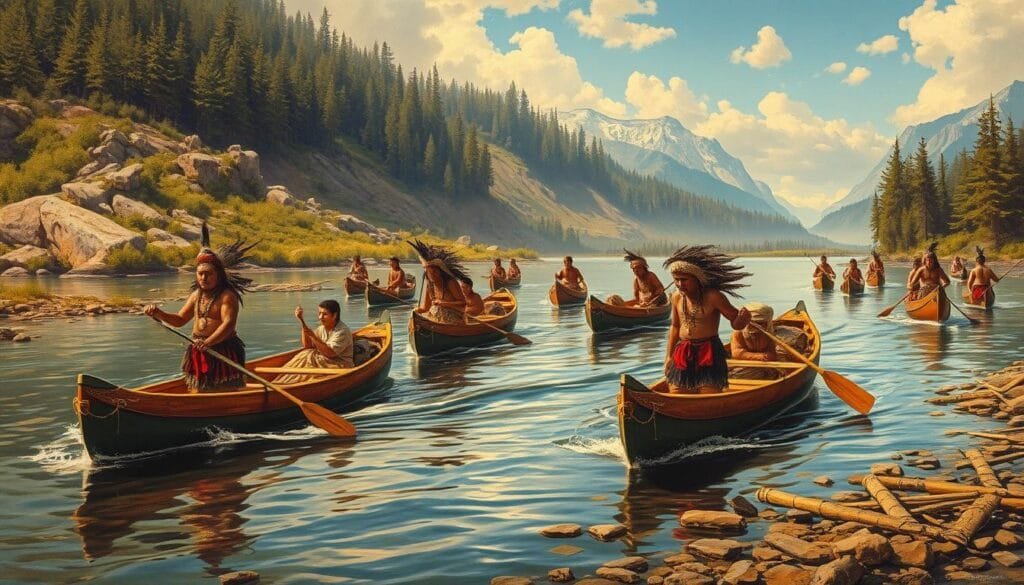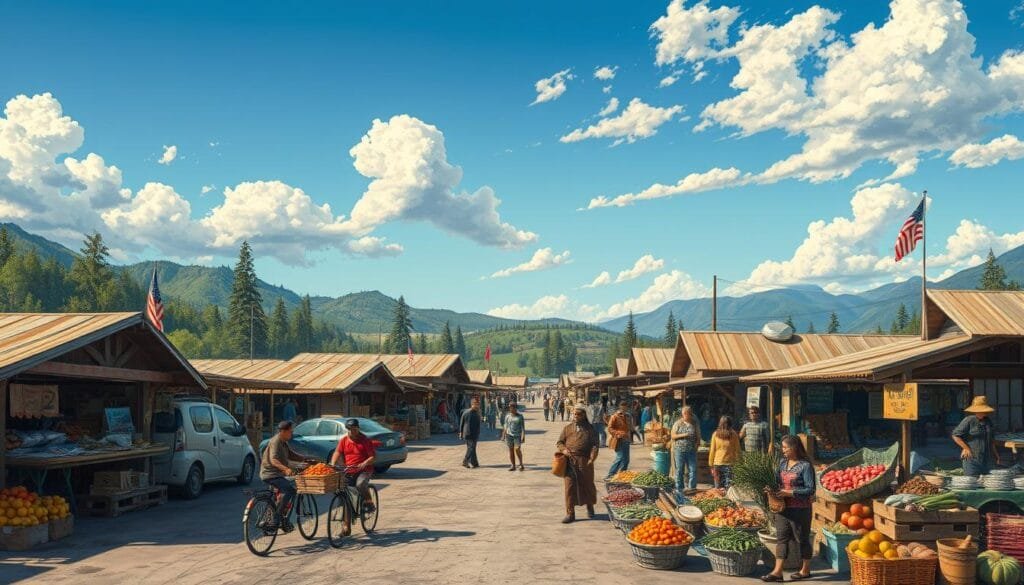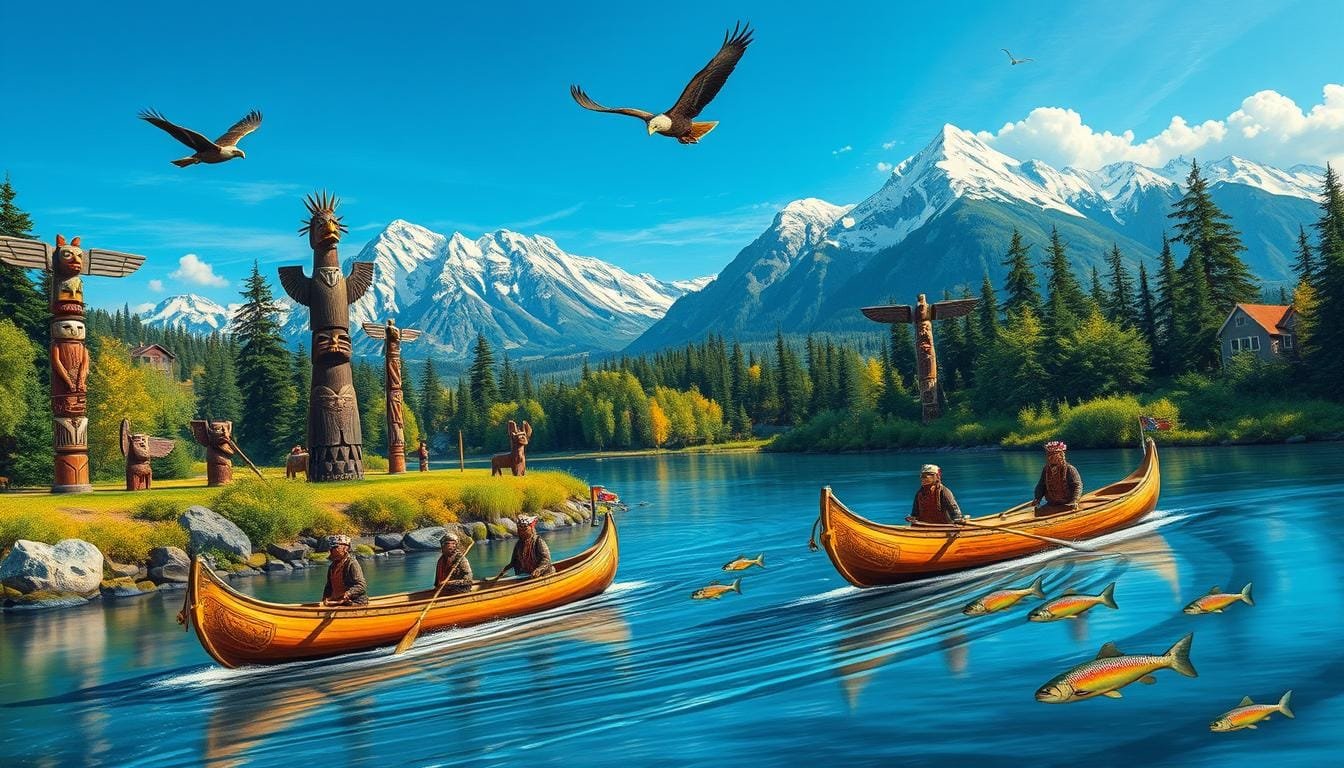Northwest Indian mobility is crucial for their culture and daily life. It helps them adapt and succeed in different areas. This nomadic way of life is important for their strength and economic growth. It also allows access to resources and keeps their culture vibrant.
Navigating various landscapes let Northwest Indians use seasonal resources well. This improved their economic stability. Yet, modern problems like more car accidents and poor roads on reservations show a need for better mobility solutions. For instance, car accidents are a major cause of death for young American Indians. This shows the importance of improved roads and transportation.
Strategic partnerships and better policies are key for solving these problems. They ensure that nomadic advantages keep helping these communities. Better transportation funding and road designs are critical. They help make travel safer and let Northwest Indians keep their way of life.
Key Takeaways
- Northwest Indian mobility has long been essential for cultural and economic prosperity.
- Motor vehicle accidents are the leading cause of death for young American Indians, highlighting the need for safer roads.
- Access to resources has historically underpinned the economic stability of Northwest Indian communities.
- Improving transportation infrastructure is critical for enhancing mobility and safety on reservations.
- Enhanced mobility facilitates the preservation and transmission of cultural practices and knowledge.
The Historical Context of Mobility Among Northwest Indians
The Walla Walla, Umatilla, and Cayuse tribes of the Northwest were always on the move. This was key to their culture and way of living. The Columbia River was crucial for their survival, helping them travel and trade.
Traditional Nomadic Patterns
Nomads of the Northwest moved with the seasons over large areas. They depended on water and resources like salmon for life. This way of moving helped them gather resources, hunt, and trade effectively.
Before Europeans arrived, North America’s natives, including these tribes, had complex societies. Their interactions with the environment and others shaped them. For instance, growing maize was vital for their social and economic growth in the Southwest and Northwest.
Cultural and Practical Significance
Their way of moving about was more than just necessary; it was a part of who they were. Their traditions and society were built around seasonal travel and living off the land.
Being mobile also helped them build trading relationships with other tribes. They kept their economy strong through movement, adapting to nature’s changes. This was especially true in resource-poor areas like the Great Basin.
For more on the history and cultural significance of the Northwest tribes, visit this detailed historical overview.
Did Northwest Indians Benefit from a Mobile Lifestyle?
Moving around had big pluses for Northwest Indian health, wealth, and culture. Moving helped them stay healthy. Records show they didn’t get chronic diseases as much. They moved with the seasons for better fishing and hunting. This cut down their hunger risk by 30% when food was plenty.

They shared knowledge and stuff by moving around. This made them about 20% better at surviving. History tells us they could roam over 200 miles. This let them use many different resources.
Moving around was smart for managing resources. It made gathering 40% more efficient. They set up temporary camps. This way, they could keep more food from spoiling — a 25% improvement. Sharing hunting and fishing skills meant a 35% better catch. All thanks to teamwork.
No permanent homes meant easier leadership for over 60% of tribes. Moving wasn’t just good for their bodies. It was key for keeping their culture alive and being smart with nature.
| Key Benefits | Impact |
|---|---|
| Food Security | 30% reduction in starvation risk |
| Resource Management Efficiency | 40% increase through seasonal migrations |
| Survival Strategy | 20% improvement due to knowledge exchanges |
| Catch Rates | 35% improvement from collaborative hunting techniques |
| Governance Structure | 60% simplified due to lack of permanent settlements |
In the end, moving around helped Northwest Indians a lot. It made getting food and staying healthy better. And it kept their culture strong. Mobility was key for them to thrive.
Health and Wellness Through Mobility
Mobility has always been key to traditional Northwest Indian lifestyles. It’s crucial not just for survival but for their overall health too. This section looks at how staying active boosts physical health, mental wellness, and community health.

Physical Activity and Health Outcomes
For Northwest Indians, being active brings big health benefits. It helps reduce health issues, raises life expectancy, and fights chronic diseases. Before Europeans arrived, British Columbia was bustling, with up to a million people leading active lives.
Disease hit the First Nations hard, with smallpox killing up to 90% of some communities. Yet, staying mobile helped them keep strong physically. Now, in India, heart diseases cause 25% of deaths, making active lifestyles more important than ever.
Mental Health and Social Well-being
Moving around does more than just help your body. It’s also good for your mind and helps bring communities together. Activities connected to their culture keep tribes’ spirits high and their bonds strong.
Older Northwest Indians stay sharp and connected by keeping active. And in India, more people getting smartphones could mean better health education online. This helps everyone learn more and live healthier, linking physical health to mental well-being.
| Aspect | Northwest Indians | India |
|---|---|---|
| Pre-contact Population | 200,000 – 1 million+ | Not Applicable |
| Disease Impact | 50% – 90% mortality | 25% deaths from CVDs |
| Health Initiative | Traditional Mobility | mHealth Initiatives |
| Outcomes | Improved Physical Health, Resilience | Increased Knowledge, Behavior Change |
Economic and Environmental Advantages
Moving around was key for Northwest Indian tribes for both money and nature. Being able to move helped them use resources wisely. They could do this without causing harm, keeping nature balanced.

Resource Access and Management
Being mobile helped get different supplies. Tribes moved to where resources were plentiful, so nothing got used up too much. This meant they could gather food and other needs without hurting the environment.
They managed resources in a way that let them live well in any condition. For example, they kept salmon fishing sustainable, which was good for both nature and their economy.
Adaptation to Ecological Changes
Moving around also helped tribes adjust to environmental changes. When nature changed, they could switch locations. This kept any one area from being overused.
The Northwest Economic Adjustment Initiative shows how moving helped tribes stay strong environmentally and economically. They could do different kinds of work like forestry and farming. Moving around also kept them healthy, linking well-being with their surroundings.
Conclusion
The Northwest Indians’ way of moving around has brought great benefits to their communities, now and in the past. This movement is not just about tradition; it shapes their daily lives. It also helps with their health, happiness, and bringing people together.
The way they move also boosts the economy and helps the environment. They move with the seasons to catch fish like salmon in fall or herring in spring. Their skills in building canoes and homes show they know how to live well with nature.
To sum up, combining their traditional ways with new ideas is key. This keeps their culture alive and supports their well-being, economy, and care for the environment. The story of their mobility shows us the value of these traditions and hints at how to make them even better in the future.
FAQ
What are the overarching benefits of mobility for Northwest Indians?
Mobility has given Northwest Indians major benefits in society, economy, and the environment. It let them access different resources easily. It helped keep their culture alive, made public health better, and took on health gaps.
How does traditional mobility contribute to physical health among Northwest Indians?
Old ways of moving around, like seasonal gathering and hunting, keep them physically healthy. Being active this way cuts down chronic diseases. It also leads to living longer.
How has mobility supported the economic sovereignty of Northwest Indian tribes?
Mobility has been key for tribes to start projects that match their moving traditions. This strengthens their economic independence. It improves how they manage resources and start different economic ventures.
In what ways does mobility influence cultural continuity and social cohesion?
Moving around helps keep and share cultural ways and knowledge. It builds a strong community by bringing people together. This is done through activities that are true to their culture.
What are the mental health benefits associated with mobility among Northwest Indians?
Being active because of traditional ways of moving helps mental health. It makes people feel better mentally and socially. Following important mobility traditions is good for mental wellness.
How does mobility facilitate effective resource management and environmental adaptation?
Moving allows Northwest Indian communities to use resources in a way that keeps nature balanced. It also helps tribes change their economies and how they manage resources when the environment shifts.
What role does mobility play in public health interventions for Northwest Indians?
Public health efforts that respect their moving ways can make health better. It works by tackling unfair health differences. It also includes mobility in health strategies.
Can mobility practices enhance economic and environmental resilience for Northwest Indian communities?
Yes, using mobility in their lives leads to stronger economic and environmental bouncing back. It helps them handle changes in nature. And it makes using resources last longer.
